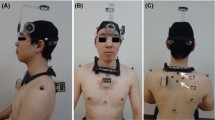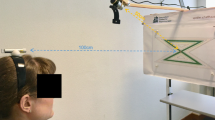Abstract
Background and Purpose
The use of virtual reality (VR) for assessment and intervention of neck pain has previously been used and shown reliable for cervical range of motion measures. Neck VR enables analysis of task-oriented neck movement by stimulating responsive movements to external stimuli. Therefore, the purpose of this study was to establish inter-tester reliability of neck kinematic measures so that it can be used as a reliable assessment and treatment tool between clinicians.
Methods
This reliability study included 46 asymptomatic participants, who were assessed using the neck VR system which displayed an interactive VR scenario via a head-mounted device, controlled by neck movements. The objective of the interactive assessment was to hit 16 targets, randomly appearing in four directions, as fast as possible. Each participant was tested twice by two different testers.
Results
Good reliability was found of neck motion kinematic measures in flexion, extension, and rotation (0.64–0.93 inter-class correlation). High reliability was shown for peak velocity globally (0.93), in left rotation (0.9), right rotation and extension (0.88), and flexion (0.86). Mean velocity had a good global reliability (0.84), except for left rotation directed movement with moderate reliability (0.68). Minimal detectable change for peak velocity ranged from 41 to 53 °/s, while mean velocity ranged from 20 to 25 °/s.
Conclusions
The results suggest high reliability for peak and mean velocity as measured by the interactive Neck VR assessment of neck motion kinematics. VR appears to provide a reliable and more ecologically valid method of cervical motion evaluation than previous conventional methodologies.


Similar content being viewed by others
References
Lidgren L (2008) Preface: neck pain and the decade of the bone and joint 2000–2010. Spine 33:S1–S2
Hogg-Johnson S, van der Velde G, Carroll LJ, Holm LW, Cassidy JD, Guzman J, Cote P, Haldeman S, Ammendolia C, Carragee E, Hurwitz E, Nordin M, Peloso P (2008) The burden and determinants of neck pain in the general population: results of the bone and joint decade 2000–2010 task force on neck pain and its associated disorders. Spine 33:S39–S51
Childs JD, Cleland JA, Elliott JM, Teyhen DS, Wainner RS, Whitman JM, Sopky BJ, Godges JJ, Flynn TW (2008) Neck pain: clinical practice guidelines linked to the international classification of functioning, disability, and health from the orthopaedic section of the American physical therapy association. J Orthop Sports Phys Ther 38:A1–A34
Chiu TTW, Lo SK (2002) Evaluation of cervical range of motion and isometric neck muscle strength: reliability and validity. Clin Rehab 16(8):851–858
Falla D (2004) Unravelling the complexity of muscle impairment in chronic neck pain. Man Ther 9:125–133
O’Leary S, Falla D, Elliott JM, Jull G (2009) Muscle dysfunction in cervical spine pain: implications for assessment and management. J Orthop Sports Phys Ther 39:324–333
Feipel V, Salvia P, Klein H, Rooze M (2006) Head repositioning accuracy in patients with whiplash-associated disorders. Spine 31:E51–E58
Woodhouse A, Liljeback P, Vasseljen O (2010) Reduced head steadiness in whiplash compared with non-traumatic neck pain. J Rehabil Med 42:35–41. doi:10.2340/16501977-0484
Sjölander P, Michaelson P, Jaric S, Djupsöbacka M (2008) Sensorimotor disturbances in chronic neck pain- range of motion, peak velocity, smoothness of movement, and repositioning acuity. Man Ther 13:122–131
Röijezon U, Björklund M, Bergenheim M, Djupsjöbacka M (2008) A novel method for neck coordination exercise—a pilot study on persons with chronic non-specific neck pain. J Neuroeng Rehab. doi:10.1186/1743-0003-1185-1136
Takasaki H, Treleaven J, Johnston V, Jull G (2013) Contributions of physical and cognitive impairments to self-reported driving difficulty in chronic whiplash-associated disorders. Spine 38:1554–1560
Sarig Bahat H, Weiss PL, Sprecher E, Krasovsky A, Laufer Y (2014) Do neck kinematics correlate with pain intensity, neck disability or with fear of motion? Man Ther 19:252–258
Roijezon U, Djupsjobacka M, Bjorklund M, Hager-Ross C, Grip H, Liebermann DG (2010) Kinematics of fast cervical rotations in persons with chronic neck pain: a cross-sectional and reliability study. BMC Musculoskeletal Disorders 11:1–10
Niederer D, Vogt L, Wilke J, Rickert M, Banzer W (2015) Age-related cutoffs for cervical movement behaviour to distinguish chronic idiopathic neck pain patients from unimpaired subjects. Eur Spine J 24:493–502. doi:10.1007/s00586-014-3715-y
Tsang SMH, Szeto GPY, Lee RYW (2014) Altered spinal kinematics and muscle recruitment pattern of the cervical and thoracic spine in people with chronic neck pain during functional task. J Electromyogr Kinesiol 24:104–113. doi:10.1016/j.jelekin.2013.10.011
Rizzo A, Kim GJ (2005) A SWOT analysis of the field of virtual reality rehabilitation and therapy. Presence Teleoperators Virtual Environ 14:119–146
Kramer M, Honold M, Hohl K, Bockholt U, Rettig A, Elbel M, Dehner C (2009) Reliability of a new virtual reality test to measure cervicocephalic kinaesthesia. J Electromyogr Kinesiol 19:e353–e361
Lee JH, Ku J, Cho W, Hahn WY, Kim IY, Lee S-M, Kang Y, Kim DY, Yu T, Wiederhold BK, Wiederhold MD, Kim SI (2003) A virtual reality system for the assessment and rehabilitation of the activities of daily living. Cyberpsychol Behav 6:383–388
Lengenfelder J, Schultheis MT, Al-Shibabi T, Mourant R, DeLuca J (2002) Divided attention and driving: a pilot study using virtual reality technology. J Head Trauma Rehab 17:26–37
Maani CV, Hoffman HG, Morrow M, Maiers A, Gaylord K, McGhee LL, DeSocio PA (2011) Virtual reality pain control during burn wound debridement of combat-related burn injuries using robot-like arm mounted VR goggles. J Trauma Injury Infect Crit Care 71:S125–S130
Merians AS, Poizner H, Boian R, Burdea G, Adamovich S (2006) Sensorimotor training in a virtual reality environment: does it improve functional recovery poststroke? Neurorehabil Neural Repair 20:252–267
Sarig Bahat H, Weiss PL, Laufer Y (2009) Cervical motion assessment using virtual reality. Spine 34:1018–1024
Sarig Bahat H, Chen X, Reznik D, Kodesh E, Treleaven J (2015) Interactive cervical motion kinematics: sensitivity, specificity and clinically significant values for identifying kinematic impairments in patients with chronic neck pain. Man Ther 20:295–302. doi:10.1016/j.math.2014.10.002
Sarig-Bahat H, Weiss PL, Laufer Y (2010) Neck pain assessment in a virtual environment. Spine 35:E105–E112
Hogan N (1984) An organizing principle for a class of voluntary movements. J Neurosci 4:2745–2754
Nelson WL (1983) Physical principles for economies of skilled movements. Biol Cybern 46:135–147
Vikne H, Bakke ES, Liestøl K, Sandbæk G, Vøllestad N (2013) The smoothness of unconstrained head movements is velocity-dependent. Hum Mov Sci 32:540–554. doi:10.1016/j.humov.2012.12.013
Bland J, Altman D (1986) Statistical methods for assessing agreement between two methods of clinical measurement. Lancet 1:307–310
Tsang SMH, Szeto GPY, Lee RYW (2013) Movement coordination and differential kinematics of the cervical and thoracic spines in people with chronic neck pain. Clin Biomech 28:610–617. doi:10.1016/j.clinbiomech.2013.05.009
Sarig Bahat H, Weiss PL, Laufer Y (2010) The effect of neck pain on cervical kinematics, as assessed in a virtual environment. Arch Phys Med Rehabil 91:1884–1890
Chen J, Solinger AB, Poncet JF, Lantz CA (1999) Meta-analysis of normative cervical motion. Spine 24:1571–1578
Assink N, Bergman GJD, Knoester B, Winters JC, Dijkstra PU, Postema K (2005) Interobserver reliability of neck-mobility measurement by means of the flock-of-birds electromagnetic tracking system. J Manip Physiol Ther 28:408–413
Audette I, Dumas JP, Cote JN, De Serres SJ (2010) Validity and between-day reliability of the cervical range of motion (CROM) device. J Orthop Sports Phys Ther 40:318–323. doi:10.2519/jospt.2010.3180
Cagnie B, Cools A, De Loose V, Cambier D, Danneels L (2007) Reliability and normative database of the Zebris cervical range-of-motion system in healthy controls with preliminary validation in a group of patients with neck pain. J Manip Physiol Ther 30:450
Sarig Bahat H, Takasaki H, Chen X, Bet-Or Y, Treleaven J (2015) Cervical kinematic training with and without interactive VR training for chronic neck pain—a randomized clinical trial. Man Ther 20:68–78. doi:10.1016/j.math.2014.06.008
Juul T, Langberg H, Enoch F, Sogaard K (2013) The intra- and inter-rater reliability of five clinical muscle performance tests in patients with and without neck pain. BMC Musculoskelet Disord 14:339
Treleaven J, Battershill J, Cole D, Fadelli C, Freestone S, Lang K, Sarig- Bahat H (2015) Virtual reality for neck rehabilitation: simulator sickness incidence and susceptibility. Virtual Real. doi:10.1007/s10055-015-0266-4
Acknowledgments
We would like to thank Prof. Yocheved Laufer and Prof. Tamar (Patrice) Weiss who supervised Dr. Sarig Bahat in her PhD, which established the foundations for neck motion analysis using VR. No funding was provided to support this study.
Author information
Authors and Affiliations
Corresponding author
Ethics declarations
Conflict of interest
None of the authors has any potential conflict of interest.
Rights and permissions
About this article
Cite this article
Bahat, H.S., Sprecher, E., Sela, I. et al. Neck motion kinematics: an inter-tester reliability study using an interactive neck VR assessment in asymptomatic individuals. Eur Spine J 25, 2139–2148 (2016). https://doi.org/10.1007/s00586-016-4388-5
Received:
Revised:
Accepted:
Published:
Issue Date:
DOI: https://doi.org/10.1007/s00586-016-4388-5




